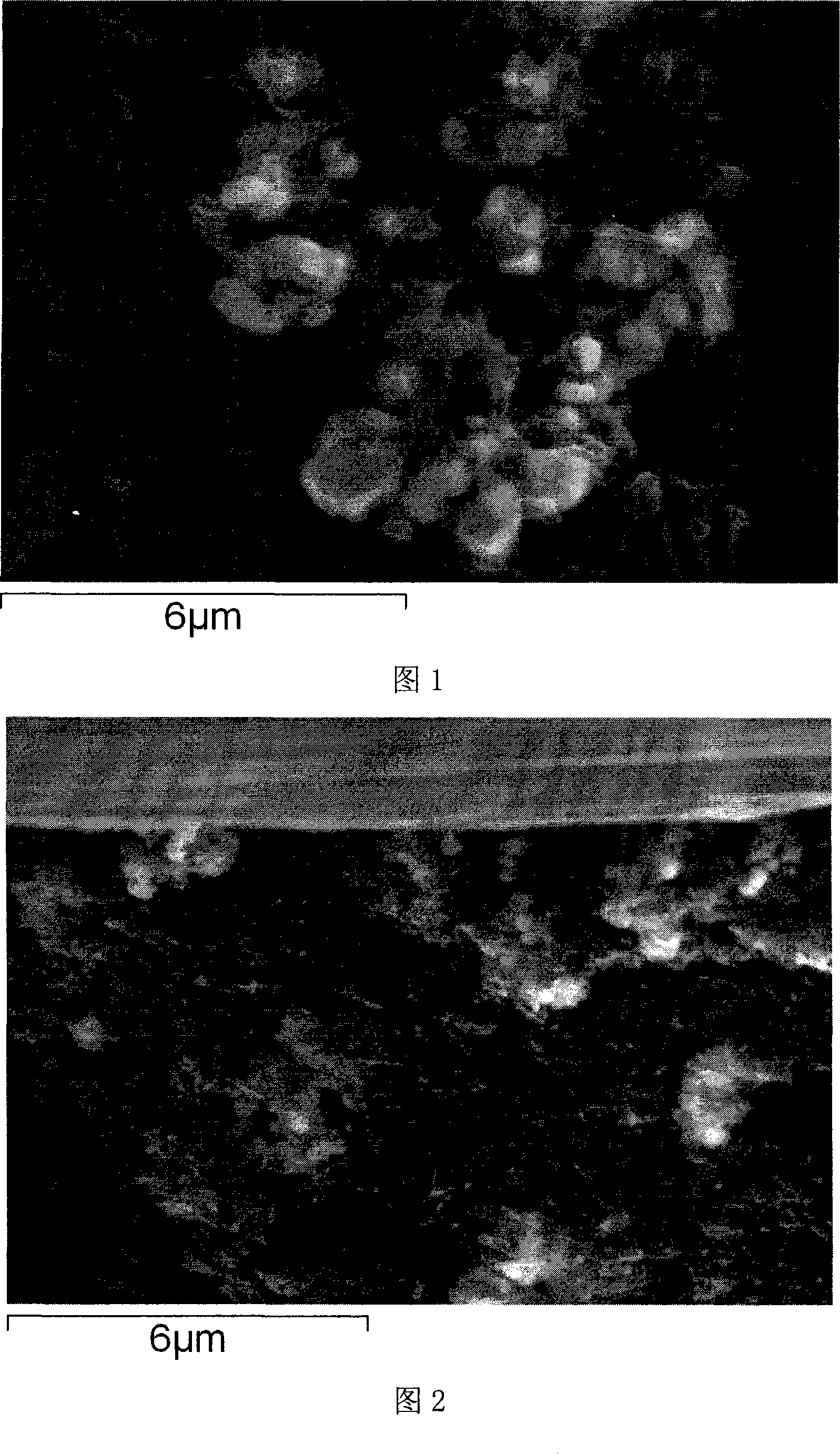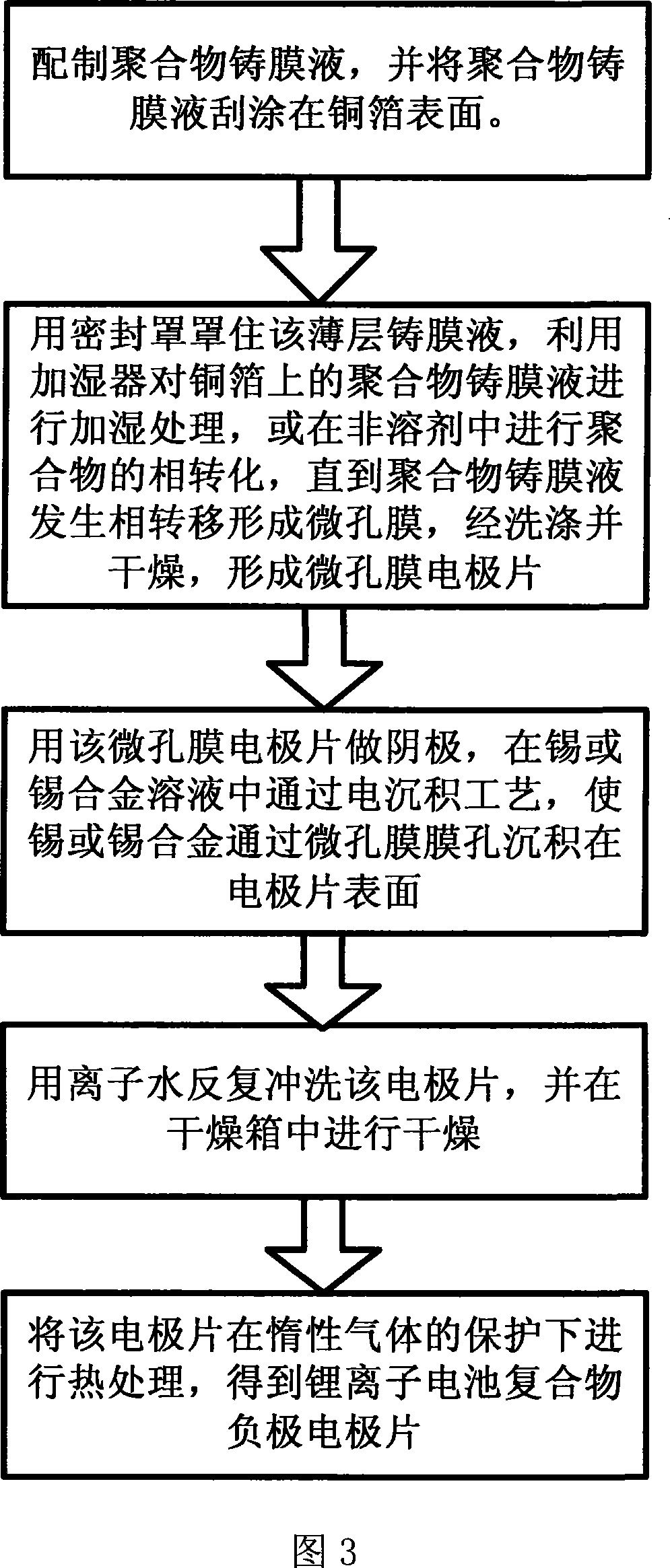Method for making negative pole of lithium ion battery with compound structure via electric sediment technology
A lithium-ion battery and composite structure technology, applied in the direction of alkaline storage battery electrodes, etc., can solve the problems such as the first charge-discharge efficiency and cycle performance, etc., and achieve the advantages of convenient electrode fabrication, long cycle life and low cost. Effect
- Summary
- Abstract
- Description
- Claims
- Application Information
AI Technical Summary
Problems solved by technology
Method used
Image
Examples
Embodiment 1
[0027] Embodiment 1. Get 1 gram of polyacrylonitrile resin and be dissolved in 20 milliliters of dimethylformamide, stir solution until transparent, obtain 5% casting solution. Use a scraper to scrape the casting solution on a 20 micron thick copper plate into a thin layer of casting solution 20-30 microns thick, cover the thin layer of casting solution with a sealing cover, and add 20 grams of it within 5 minutes with a humidifier water. After soaking the obtained phase transfer microporous membrane in deionized water for 2 hours, after washing and drying several times, a microporous membrane electrode sheet with a pore size of about 1 micron is obtained, and the porous membrane electrode sheet is used as the cathode, and the tin block is used as the anode , respectively electroplating in tin, copper-tin alloy, tin-antimony alloy, tin-nickel alloy electroplating solution, and then rinse the electro-deposited pole piece repeatedly with deionized water and dry it in a drying ov...
Embodiment 2
[0028] Embodiment 2. Dissolve 0.9 gram of polyacrylonitrile and 0.1 gram of polyvinylidene fluoride in 20 milliliters of dimethylformamide, stir the solution until it is transparent, and obtain a 5% casting solution. Use a scraper to scrape the casting solution on a 20 micron thick copper plate into a thin layer of 20-30 micron thick casting solution, cover the thin layer of casting solution with a sealing cover, and add 10 grams of it within 5 minutes with a humidifier water. After soaking the obtained phase transfer microporous membrane in deionized water for 2 hours, after repeated washing and drying, a microporous membrane electrode sheet with a pore size of about 5 microns was obtained, as shown in Figure 2, the porous membrane electrode sheet was used as the The cathode and the tin block are used as the anode, and are electroplated in tin, copper-tin alloy, tin-antimony alloy, and tin-nickel alloy electroplating solutions, and then the electrodes after electrodeposition ...
Embodiment 3
[0029] Embodiment 3. Get 0.6 gram of polyacrylonitrile and dissolve in 10 milliliters of dimethylformamide and 10 milliliters of dimethyl sulfoxide, stir the solution until it is transparent, and obtain a 3% casting solution. With a scraper, the casting solution is scraped into a 20-micron thick thin layer casting solution on a 10 micron thick copper plate, and the thin layer casting solution is covered with a sealing cover, and 5 grams of water are added in 3 minutes with a humidifier. The obtained phase-transfer microporous membrane is soaked in 0.2% saline by weight for 2 hours, washed and dried several times, to obtain a microporous membrane electrode sheet with a pore diameter of about 3-10 microns, and use the porous membrane electrode sheet As the cathode and the tin block as the anode, electroplating is performed in tin, copper-tin alloy, tin-antimony alloy, and tin-nickel alloy plating solution, and then the electrodes after electrodeposition are rinsed repeatedly with...
PUM
| Property | Measurement | Unit |
|---|---|---|
| Thickness | aaaaa | aaaaa |
| Thickness | aaaaa | aaaaa |
| Aperture | aaaaa | aaaaa |
Abstract
Description
Claims
Application Information
 Login to View More
Login to View More - Generate Ideas
- Intellectual Property
- Life Sciences
- Materials
- Tech Scout
- Unparalleled Data Quality
- Higher Quality Content
- 60% Fewer Hallucinations
Browse by: Latest US Patents, China's latest patents, Technical Efficacy Thesaurus, Application Domain, Technology Topic, Popular Technical Reports.
© 2025 PatSnap. All rights reserved.Legal|Privacy policy|Modern Slavery Act Transparency Statement|Sitemap|About US| Contact US: help@patsnap.com


